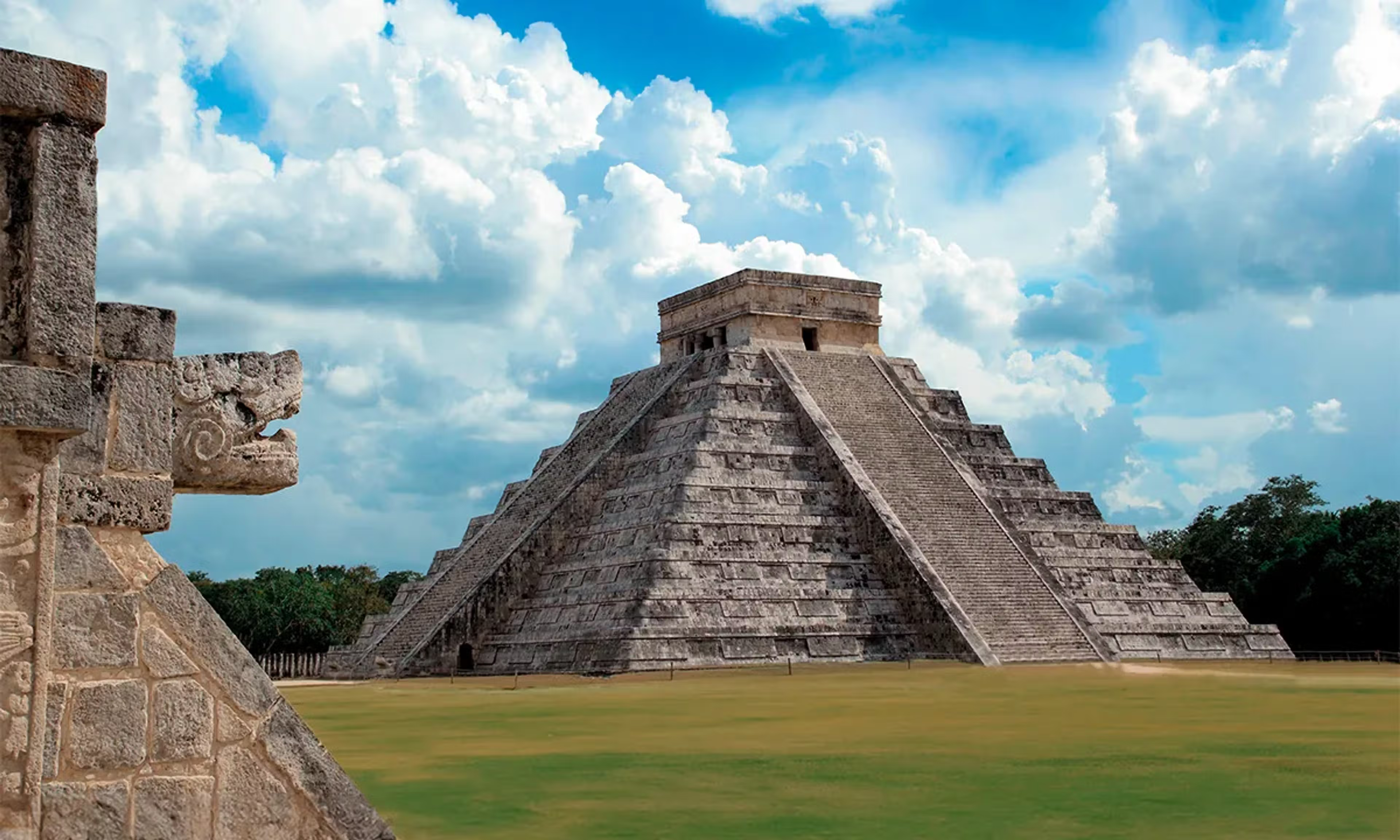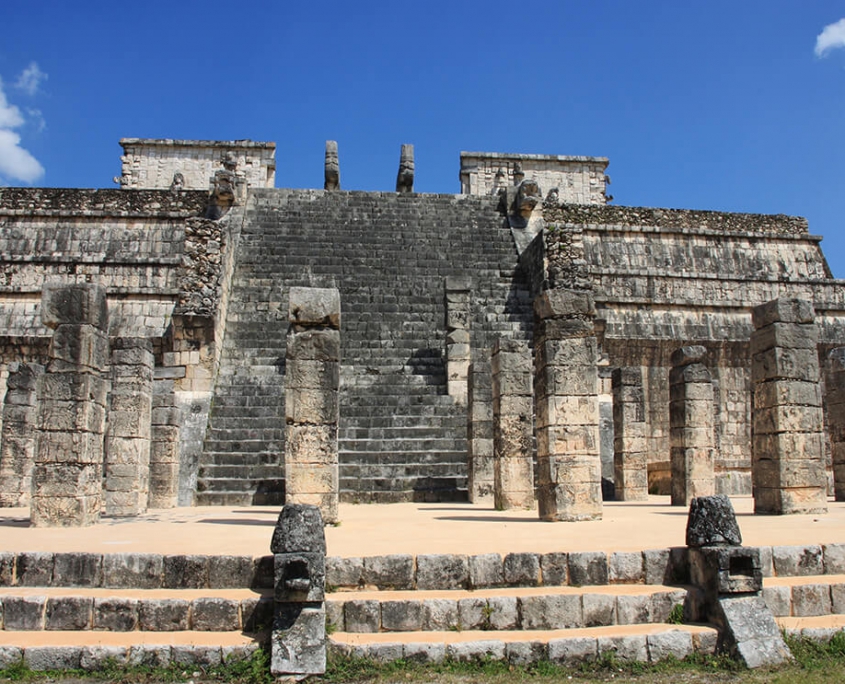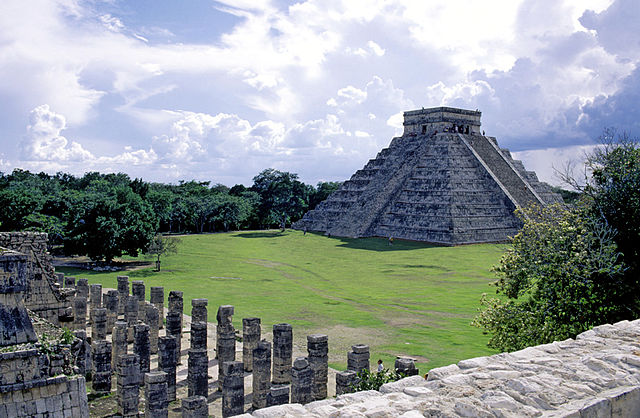Introduction
Chichén Itzá, the majestic pre-Columbian Maya city on Mexico’s Yucatán Peninsula, remains one of the most iconic archaeological sites in the world. Its pyramids, plazas, ball courts, observatories, and cenotes speak of a civilization that was deeply astronomical, religious, artistic, and politically powerful.
Below are seven fascinating facts about Chichén Itzá that reveal why this ancient site continues to captivate visitors and scholars alike.
Fact 1: El Castillo – A Pyramid That Is Also a Calendar
At the heart of Chichén Itzá stands El Castillo (Temple of Kukulcán), a stepped pyramid that serves as much more than a monument — it’s an astronomical calendar in stone.
Each of the four staircases has 91 steps; adding the top platform totals 365, corresponding to the days in the solar year.
Twice a year — during the spring and autumn equinoxes — sunlight and shadow create a mesmerizing illusion: a serpent-like pattern appears to descend the pyramid’s steps toward the carved serpent heads at the base, symbolizing the feathered serpent deity Kukulcán.
This brilliant design proves that the Maya architects were precise astronomers, perfectly attuned to the celestial cycles that governed both their calendar and spiritual life.
Fact 2: Chichén Itzá Was a Melting Pot of Cultures
Chichén Itzá was not purely Maya throughout its development. By the 10th century, it became a fusion of cultures, influenced heavily by the Toltecs of central Mexico.
The Temple of the Warriors, with its colonnades of carved warrior figures, and motifs such as feathered serpents, reflect strong Toltec influence.
This blend of Maya and Toltec styles created a unique hybrid city that stood out in regional dominance, artistry, and architecture, symbolizing unity through cultural exchange.
Fact 3: The Great Ball Court’s Astonishing Acoustics
Among the many wonders at Chichén Itzá, the Great Ball Court is one of the largest in all of Mesoamerica — stretching hundreds of feet long. It was used to play Pok-ta-Pok, a ritual ballgame with profound religious and social meaning.
Visitors are often amazed by the acoustics of this vast court: whispers at one end can be heard clearly at the other.
This acoustic precision reflects not only Maya architectural mastery but perhaps a ceremonial purpose — amplifying voices of rulers or priests during sacred games and rituals.

Fact 4: Sacred Cenote – Portal to the Gods and Source of Water
Water is scarce in the Yucatán due to its limestone landscape and lack of surface rivers. The region’s life-sustaining cenotes (sinkholes) provided access to fresh groundwater — and deep spiritual meaning.
The name “Chichén Itzá” means “at the mouth of the well of the Itzaes,” referring to these natural wells.
The Sacred Cenote (Cenote Sagrado) was especially vital — both a source of water and a ritual portal to the gods. Excavations have revealed ceramics, jade, gold, shell ornaments, incense, and even human remains, evidence of offerings and sacrifices to rain and fertility deities, especially during droughts.
Fact 5: El Caracol — The Maya Observatory
The Maya’s fascination with the cosmos is beautifully embodied in El Caracol, meaning “The Snail” (named for its spiral staircase inside).
This round tower, perched on a broad platform, is aligned with astronomical events — tracking the movements of the sun, moon, stars, and Venus, which held immense importance in Maya cosmology.
El Caracol demonstrates the Maya’s scientific brilliance, using architecture as both an observatory and a sacred tool for measuring time, predicting seasons, and aligning rituals with celestial cycles.
Fact 6: Temple of the Warriors and the “Forest” of Columns
The Temple of the Warriors is among Chichén Itzá’s most monumental and awe-inspiring complexes.
Fronted by a vast plaza filled with hundreds of carved columns — often called the “Thousand Columns” — the area once supported large roofed halls that hosted ceremonial or public gatherings.
Each column bears carvings of warriors, serpents, and symbolic motifs of power and faith. This “forest of stone” represents the political and military might of Chichén Itzá and the spiritual authority that sustained it.

Fact 7: World Heritage and Wonder – Recognition and Modern Importance
In 1988, Chichén Itzá was declared a UNESCO World Heritage Site, recognized for its outstanding universal value — an extraordinary cultural landmark of architectural and historical importance.
Later, in 2007, it earned global fame when voted one of the New Seven Wonders of the World.
Today, millions of travelers visit each year to experience its astronomy, art, and mythology firsthand. This global recognition fuels both tourism and conservation efforts, while reminding the world of the need to protect its fragile stones and sacred legacy.
Yet, such popularity also poses challenges — balancing preservation, access, and respect for the site’s cultural and environmental integrity.
Bonus Facts: Hidden Pyramids and the White Roads (Sacbeob)
Pyramids Beneath Pyramids
El Castillo itself hides earlier pyramids inside — smaller, older structures over which newer ones were built. Archaeologists have uncovered these layers, revealing Chichén Itzá’s multi-phase construction and spiritual evolution.
Sacbeob – The White Roads
The Maya built a network of paved white roads (sacbeob) that connected temples, plazas, and nearby settlements. Over 80 sacbeob have been identified, reflecting advanced urban planning and connectivity across the region.

Challenges and Conservation Efforts
Preserving Chichén Itzá is an ongoing effort. The site faces natural erosion, humidity, visitor impact, and environmental pressures.
Authorities, archaeologists, and local communities work tirelessly to balance heritage protection, tourism management, and sustainable development. Laws, site management plans, and restricted access to sensitive areas all help protect this irreplaceable monument for future generations.
Conclusion: The Timeless Legacy of Chichén Itzá
Chichén Itzá is far more than a collection of ruins — it’s a living testament to Maya genius, cosmic understanding, and cultural depth.
These seven (and more) fascinating facts offer only a glimpse into a city where astronomy met architecture, religion guided science, and stone spoke with the language of the stars.
Whether you visit in person or explore through history, Chichén Itzá continues to inspire awe, curiosity, and respect — a sacred reminder that human civilization once looked to the heavens and built wonders that still endure.
Tags
PrimeOne Tour
Expert travel guide specializing in Maya culture and history.

